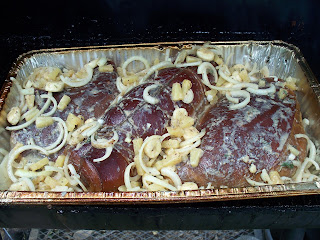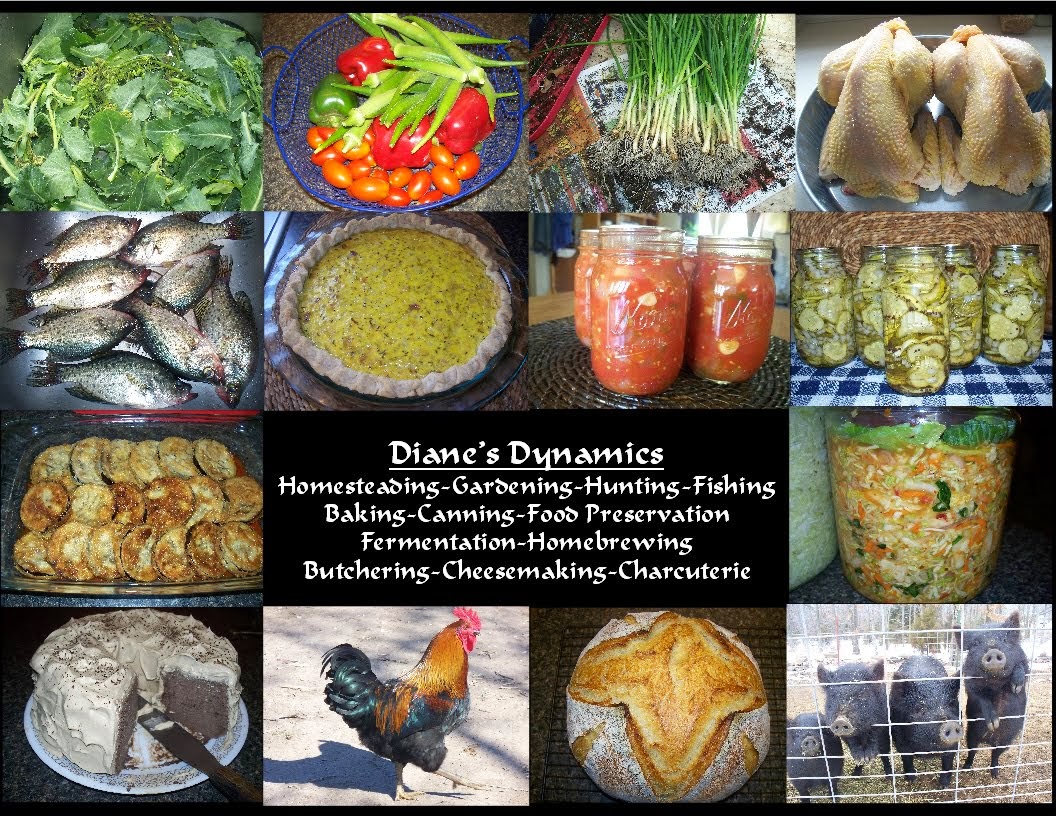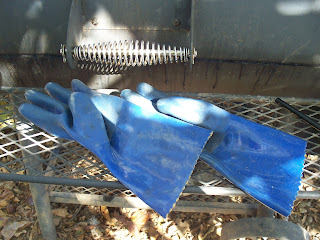 |
| AGH Porchetta with (left) Coconut/Pineapple Au Jus and (right) Corn Relish |
The first year we raised hogs, we started off with a couple
of Hampshire feeders. They were strictly for experiment, to see if it was
really something we could commit to long-term. They reached a nice weight of
about 150 pounds around April, so I decided to slaughter and butcher them. I
have always done my own processing and grew up in “The Wild Hog Capital of the
World,” the Texas Panhandle. By the time
I got done skinning and cutting that Hamp into primals, I knew I had made a
mistake! The one I processed a month later was even worse – triple-digit heat
and blow-flies crawling all over the carcass. Lesson learned. There is a reason
large homestead hogs have traditionally always been processed (and cured!) during
cooler weather!
We purchased our first American Guinea Hogs about 5 years ago. Last
year, I found myself up to my ears in pigs – around 25 at the beginning of
spring, along with a saturated market for the few who wanted them, plus we live in an area where feeders/weaners (shoats)
of larger breeds can be had for as little as $25 (sometimes less at auction). I
just could not bring myself to sell such incredible-tasting meat for so little,
not even as a “stop-loss” scenario. So I got creative.
 |
| 50# Boar Shoat |
As it turns out, hot weather is the perfect time to thin the
culls. And by culls, I mean shoats (the industry term for younger boars and
gilts) that I was not planning on breeding, growing out or selling. I bought an
off-set wood smoker that will hold a whole pig weighing up to about 65 pounds,
along with some basic scalding equipment, which, in my opinion, is far, far
easier and faster than skinning. I had never used a wood smoker before and was
shocked at how easy they are to use. Mine came from Lowes (about $150 if you
watch and wait for them to go on clearance in the fall). This particular one
was made by “Oklahoma Joe’s”. The interior measures 18”x32” and the smoke box
is 15” square. It is important that the smoke-box be made from fairly-thick
steel to hold up to repeated use. And, if you are not cutting your own wood, you
will need shorter pieces than what is normally sold for wood-stoves and
fireplaces. I have since used off-set smokers made from cinder blocks, and
there are plenty of cheap ideas on the internet for different types of hot and
cold smokers. Of course, these smaller pigs can also be cooked on the grill or
in the oven – I just do not like heating my house up during the summer.
As for scalding equipment, I highly recommend a high-output
propane burner as opposed to a turkey fryer, because once you see how easy it
is to scald and scrape a pig, you may want one with the capability and
stability of heating larger amounts of water for larger hogs. I use one I
ordered through Amazon by “Gas One” for $100. It is 200,000 BTUs and the frame
is strong enough to hold a 55-gallon drum at least 2/3 full of water. At this
time I do not have a front-end loader on my tractor so I can just dip the pigs
in the barrel, so I heat water to boiling, dip it into either a 40 or 80
gallon trough, then add cool water to bring the temperature down to where I
want it. For hogs in the 45-65 pound range, that is about 150 degrees. For those of you who think it is easier to skin, I
can scald and scrape a pig that size in about 15 minutes!
 |
| 10-gallon "Tamale Steamer" for small hogs |
One of the best perks about culling some of your pigs when
they are small is that IF you were planning on castrating the boars, you can be
rid of them before they are old enough to breed or develop boar taint (which is
a separate and elaborate issue I do not want to get into here). I recommend
culling the boar shoats by 4 months and no later than 6 months. It is also
something I can do by myself, and as I get older and have more aches and pains,
it gives me a sense of accomplishment that I can dispatch, scald, scrape and
gut a pig, and have it on ice or on the smoker in a couple of hours. Nor do I
have to butcher or cure the same day – if you don’t put them directly on the
smoker or the oven before rigor sets in, it is best to let them rest for 48
hours before proceeding with butchering.
 |
| Coconut Milk, Pineapple, Cilantro, Mint, etc. added for the last hour |
Another perk of butchering young pigs is that if you do not
have a lot of processing experience, they are perfect for learning. I would
compare this to any other method of food production, be it baking, gardening, curing
or cheesemaking, even cooking a 3-course meal: if you do not DO it on a regular
basis, the job is harder and it takes longer because we tend to forget the
little things. This is also the main
reason I keep a dedicated butchering area and a butchering bag packed and ready
to use, so that I don’t have to spend an hour gathering up knives, old towels,
poultry shears, etc., and wondering where I last used the blow torch and the
sharpening steel. I make a point of butchering SOMETHING at least once a week,
even if it is just a couple old hens for soup/stock. In any case, the last thing you want to deal
with after you have put a year into growing out a larger hog is inexperience
and last-minute scrambling around only to discover you forgot to keep your propane
tanks filled or you can’t find your hacksaw!
I have now put many a whole shoat on the smoker, ranging from
25#-65#. They are cooked “low and slow” which is in the 200-225 degree range.
It takes about 8-10 hours to smoke a whole hog (average 50#) to a safe internal
temperature of 160. With AGH, I do not inject and I use little in the way of
additional flavors because it just isn’t necessary with such
outstandingly-flavored pork. At most, I rub a small handful of “Tony
Chachere’s” seasoning into the cavity. With the skin still attached, you will
not need to baste, as the skin holds the juices in. If you are smoking an
uncastrated boar in the 6-month range, I
highly recommend putting them on the grate with the cavity-side down for the
first half of cooking, then turning them skin-side-down for the last half. IF
there is any taint, this is the only method I have found that helps – the taint
is in the fat and dripping some of the fat and juices out will get rid of most
of the aroma. The smoke flavor masks the rest.
(A pair of heavy PVC gloves makes handling whole hogs or
large parts on the smoker a breeze!)
If you cook a whole or half pig in the oven, leave it
skin-side-up during the entire cooking process. (You will need a very large
roasting pan or a couple of those giant, disposable lasagna pans for this.)
Roast it between 200-225 degrees, then for the last hour, turn the oven up to
about 450. Something amazing will happen: the skin will rise and blow up like
the bubbles in over-proofed bread and become hard and crackly. It is delicious!
Regardless of your cooking method, you can do so much with
all that smoked pork! It is delicious just as it is, but you can make pulled
pork by adding your favorite BBQ sauce, which can be served as is, or on buns.
You can take some that is already pulled and “frizzle” it in a cast iron
skillet for Carnitas or Tacos. You can stuff it in corn tortillas for
enchiladas. You can freeze it in smaller containers for fast meals later.
There’s also no reason why you can’t cure the shoulders and
hams of smaller pigs. From a 50#
pig, you’ll end up with back legs and whole shoulders weighing about 7-8#. You
can debone them, partially debone them, or leave them whole. I prefer taking out the aitch and femur (large
bones) and injecting curing solution all through the muscles. I use Ruhlman/Polcyn’s
recipe for “American-Style Brown-Sugar-Glazed Holiday Ham” (available from
their book “Charcuterie” and on the web.) You allow half a day per pound in the
brine. Please use the #1 curing salt recommended (sodium nitrite), not only for
safety, but for color. Otherwise, you will just be making pork roast, not ham. They
may also be prepared like bacon, especially if they are deboned, small and flat (don't tie them).
You can also make “Porchetta” from these small pigs, but
unlike with larger hogs where there is a large section of belly between the
ribs and back leg, you’ll want to completely remove the spine and ribs from a
carcass that has been split in half. This is much easier than it sounds, just
use a small boning or paring knife and scrape the meat away from the bones. (Don't even try to leave meat on the ribs on a small hog, just save these bones for stock!) There will be a
small section of loin left over that is attached to the shoulder blade that can
be rolled into the porchetta. It separates easily from the blade, just follow
the breaks in the muscle and trim off the skin from that chunk of loin before
rolling it into the porchetta. If you have trouble tying a porchetta, use
plastic strap-ties to hold it in place while you tie it. Remove them after the
loin is tied.
 |
| Ribs and Spine Removed |
 |
| Entire Mid-Section, Loin from Shoulder Rolled in Center |
Here is a wonderful summertime recipe (with permission from
Michael Pendley of Realtree) that I enjoy making. If you’d like to see the
original, look up the recipe on his blog where it’s called “Hawaiian-Style
Banana-Leaf-Wrapped Roasted Pork”. In
the photos, I have trimmed out the porchetta and trimmed the ham and shoulder,
then covered the exposed meat (and the inside of the porchetta) with a rub of
brown sugar, 5-spice powder, grated ginger, and a splash of soy sauce and
sesame oil. I placed them all in a roasting pan and gave them a light smoking
on the grill (about 3 hours at 200 degrees), then poured the remaining
ingredients over, covered the pan with foil and continued cooking to an
internal temp of 160. (You can raise the heat or move to the oven once the pan
is covered if you are in a hurry – otherwise, it’s an all-day affair.) Before
serving/slicing, remove the skin/fat cap from the ham and shoulder.
 |
| Rubbed (and rolled) with Brown Sugar, Ginger, Soy Sauce and 5-Spice Powder |
This is a very rich dish. Pair it with something that will absorb the juices, like plain Basmati Rice, Ramen or Orzo. For a summertime cookout, all the usual fixings will do: coleslaw, corn on the cob, a fresh tomato/cucumber salad, beets with some orange flavor, anything fresh and in-season. Fresh fruit or a trifle made with angel food cake, vanilla pudding and berries would be a great dessert. A nice cocktail pairing might be lemonade with a splash of Midori (melon liqueur). A bold Chardonnay or even bolder Pinot Noir or a fruity Old Vine Zin would be nice pairings.
Mix in a large bowl and pour over lightly-smoked pork before covering with
foil or wrapping in banana, lotus or canna leaves:
2 medium onions, sliced
3 plantains, peeled and sliced (use bananas or yams if plantains aren’t available)
1” grated ginger
¼ cup 5-spice powder
½ cup brown sugar
1 16-oz can pineapple bits, with juice
1 12-oz can coconut milk
Splash soy sauce and sesame oil
3 plantains, peeled and sliced (use bananas or yams if plantains aren’t available)
1” grated ginger
¼ cup 5-spice powder
½ cup brown sugar
1 16-oz can pineapple bits, with juice
1 12-oz can coconut milk
Splash soy sauce and sesame oil
Good garnishes: Orange Mint, Pineapple Sage, Thai Basil (any basil, really), Cilantro, Perilla/Shiso
 |
| Lightly Smoked, Additional Ingredients Added Before Covering |










No comments:
Post a Comment